Do you want to learn some dragonfly facts for kids? Learn about a dragonfly’s diet, life stages, predators, and more!

Physical Description
Dragonflies have a small head with large compound eyes that are set closely together. They have long segmented bodies with two pairs of transparent wings. Dragonflies come in a variety of colors. They can be yellow, red, brown, green, and blue. A dragonfly’s wings may have markings. Dragonflies have six long legs. Dragonflies range in length from half an inch to five inches.
Dragonfly Facts about their Habitat
Dragonflies are found all over the world near fresh water. They do not live in polar regions. They prefer warmer habitats. Dragonflies can be found near streams, rivers, ponds, lakes, and wetlands.
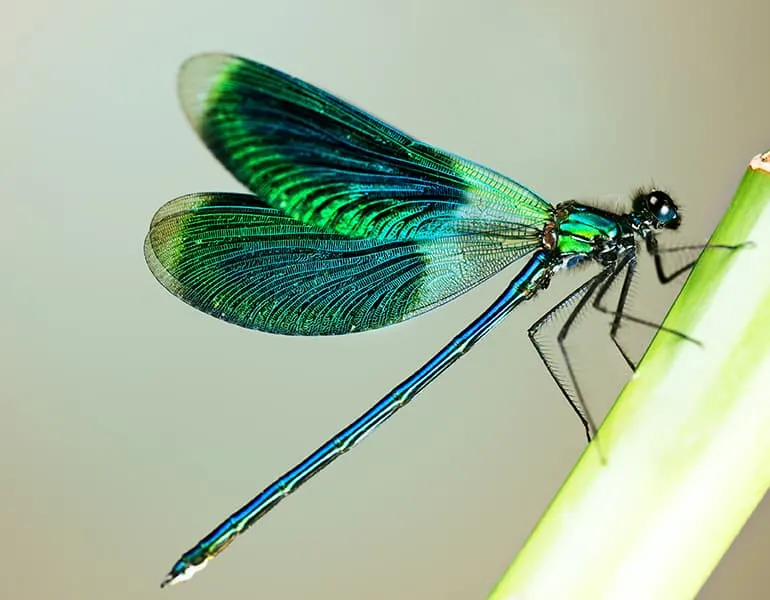
Habits
Dragonflies begin their day by warming up in the sun. They are most active during the warmest part of the day. They spend the entire day hunting and eating. Dragonflies spend most of their time in the air to avoid predators.
An interesting dragonfly fact is that they are great fliers because each wing has its own flight muscle. The muscles provide the dragonfly with the necessary strength for flight. They also enable the dragonfly to move each wing independently. These traits allow dragonflies to move quickly in different directions in order to catch their prey.
We don't know how many hours a dragonfly spends sleeping. Dragonflies find a safe place in the foliage to sleep in. It is believed that dragonflies sleep like other insects. They enter a state of torpor. Torpor is a form of hibernation in which the dragonfly’s body slows down. Torpor differs from hibernation in that it occurs over a shorter period of time. When it gets cold outside, dragonflies go into torpor until it warms up.
We know that dragonflies migrate. We don’t know much about dragonfly migration. We do know that a yearlong migration takes three generations to complete. There is no evidence that dragonflies go to a specific place to spend the winter.
Diet
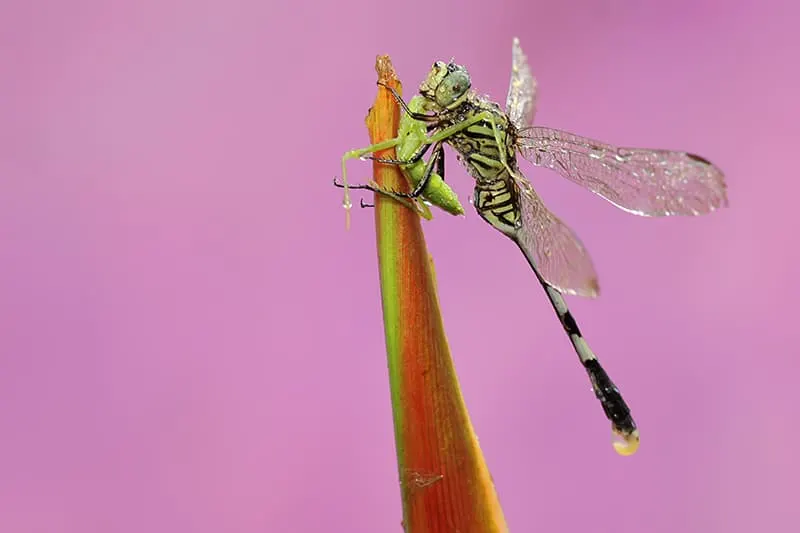
Dragonflies are carnivores. They will eat any flying insect they can find. The types of insects they eat range from flies to butterflies, mosquitos, and smaller dragonflies. The dragonfly catches its insect prey with its legs while flying.
A dragonfly will eat its prey while flying if possible. Dragonflies land to eat prey that is too heavy for them to carry. A dragonfly gets most of its water from its food but also drinks water directly.
Breeding
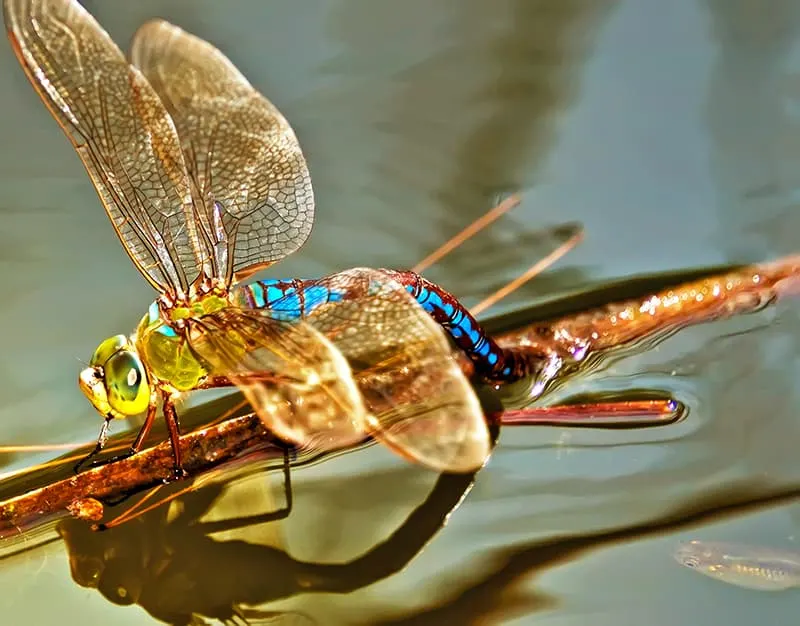
Female dragonflies find the best territory that has access to a body of water. Dragonfly mothers lay their eggs in a variety of places. Algae, open water, and cattails are some of the places where eggs can be placed.
A male dragonfly also chooses his territory. Once he chooses his territory, he will chase away all the other male dragonflies. Sometimes males compete by showing off their flying skills to each other. The one who has the best flying skills remains in the area while the other male flies off to another territory.
Male dragonflies mate with as many females as they can. Dragonflies mate one to three times a year, depending on how warm it is. The warmer it is, the more often they mate.
When the female dragonfly lays her eggs, the male dragonfly often guards her. A female dragonfly can lay up to 1000 eggs at once. She places them near water so fish can’t get to the eggs and eat them.
Offspring
Dragonfly eggs take one to five weeks to hatch. Baby dragonflies are called nymphs. Nymphs hatch with six legs, two wing sheaths and the ability to breathe underwater. Nymphs stay in the water until they are mature enough to leave.
When the nymph outgrows its exoskeleton, it sheds it. This is called “molting”. Dragonfly nymphs may molt up to 14 times as they grow into adults. They remain in the water until their final molting stage. The nymph crawls onto land when it’s ready to molt into a dragonfly. The nymph then molts one last time to become an adult dragonfly.
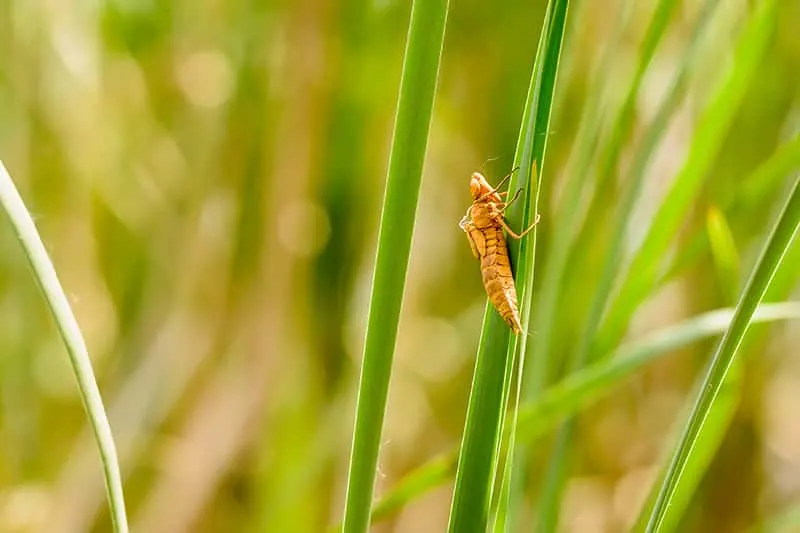
Classification/Taxonomy
Kingdom: Animalia
Phylum: Arthropoda
Class: Insecta
Order: Odonata
Family: Anisoptera
History
Insects that could fly appeared before dinosaurs. The ancestor of the dragonfly appeared about 300 million years ago. This is when some insects developed wings. The dragonfly’s ancestor was giant when compared to the dragonflies of today. Dragonfly fossils show that their wingspans were two-and-a-half feet. This implies that dragonfly ancestors were as big as crows. Except for size, dragonflies have not changed much from their ancestors.
Myth
Many cultures have stories about the dragonfly as a symbol. Dragonflies are thought to bring good luck in Japan, and the red dragonfly is considered sacred. In China, dragonflies are considered a symbol of good luck and harmony. A dragonfly represents change or purity in Native American culture. In European folklore, dragonflies were thought to be a symbol of bad luck. The name “dragonfly” comes from an old European story.
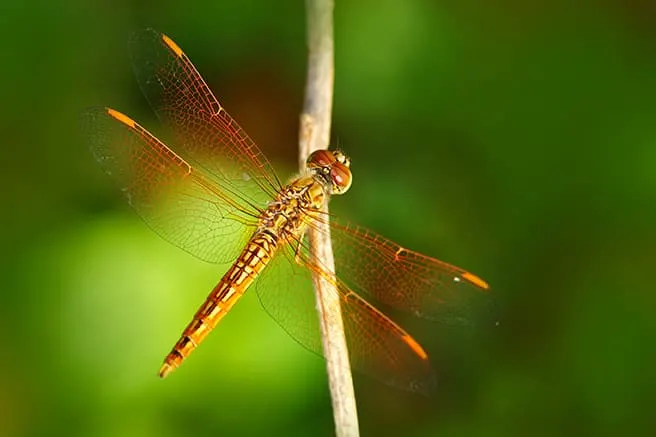
Predators
Aquatic predators of dragonfly nymphs include fish, frogs, and newts. Adult dragonflies have many predators. Adult dragonflies are a tasty snack for creatures like birds, lizards, and spiders. Humans pose the biggest threat to dragonflies because they move into areas where dragonflies live. This results in habitat loss.
Habitat loss is the biggest threat to dragonflies. According to the IUCN Red List, one-fifth of dragonflies are under threat of becoming extinct due to habitat loss. This is alarming because dragonflies eat mosquito eggs. This helps to prevent certain diseases in many parts of the world.
Lifespan
A dragonfly’s life cycle happens in stages. Dragonflies spend the longest part of their lives as nymphs. A dragonfly nymph can live for two months to two years. Adult dragonflies can live anywhere from a week to a year, depending on the species.
25+ Fascinating Dragonfly Facts
- Dragonflies shake their wings to help themselves warm up.
- Dragonflies can fly backwards, straight up and down, and hover like a helicopter.
- There is no proof that dragonflies prey on hummingbirds.
- Dragonflies fly at speeds from 10 to 30 miles an hour.
- A dragonfly spends most of its lifespan underwater as a nymph.
- A dragonfly nymph catches prey using the pincers from its mouth.
- Dragonfly nymphs eat aquatic insects, small fish, and tadpoles.
- A dragonfly that dips its tail into the water is laying eggs.
- Dragonflies don’t sting.
- Dragonflies will only bite if they feel threatened.
- Dragonflies aren’t dangerous to humans.
- A group of dragonflies is called a swarm.
- Some people think it’s good luck if a dragonfly lands on their head.
- A dragonfly’s wingspan can range from 2 to 5 inches.
- There are at least 5,000 known species of dragonfly.
- The Globe Skimmer dragonfly has the longest migration route of any insect. Its route is 11,000 miles long.
- Dragonflies catch prey by grabbing it with their feet.
- A nickname for Japan is “Island of the Dragonfly”.
- A dragonfly beats its wings 30 times per second.
- There are 450 dragonfly species in North America.
- The Giant Darner dragonfly of the American Southwest is the largest dragonfly. It has a 5-inch-long body and a 5-inch wingspan.
- Dragonflies don’t make buzzing sounds like other insects.
- Dragonflies seek shelter when it rains to avoid getting their wings wet.
- A dragonfly can’t fly with wet wings.
- A dragonfly keeps its wings open when resting; a damselfly doesn’t.
- Dragonfly eyes can detect movement that is as fast as 1/300th of a second.
- Dragonflies can see for long distances, but they can’t see fine details.
- The Scarlet Dwarf dragonfly is the smallest dragonfly. Its wingspan is less than an inch and its length is less than an inch.
- Dragonflies are used in traditional medicine in China and Japan.
We hope you enjoyed learning all about dragonflies! Did you learn any new fun facts? Let us know what else you know about them. We can’t wait to find out more.
Here are some fun insects that you might want to learn about.
